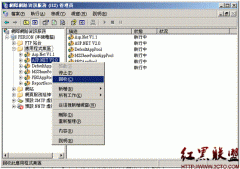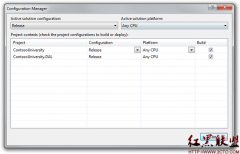利用C#实现标注式消息提示窗口
来源:网络整理 责任编辑:admin 发表时间:2013-07-01 21:31 点击:次
近一段时间由于项目需要一直专注于UI方面的编程,为了更加友好的将提示信息呈现给用户,我们必须对标准的 Windows消息提示窗口进行处理。我们大家在Windows XP下使用U盘、闪存等移动存储设备,当插上或拔下这些设备时任务栏区域都会显示一个淡黄色背景,且具有标注样式的提示窗口弹出来,这样的提示即友善又美观,那么这到底是怎么实现的呢?其实道理并不复杂,该标注式提示窗口本身就是一个不规则窗体,当显示时它会将标注窗口的箭头指向不同控件。如下图:

一般情况下的p标注式提示窗口
屏幕边缘的标注式提示窗口
一、技术要点
就像本文开头所说的"标注式消息提示窗口"其实就是一个具有不规则外形的窗体,但却具备了更加复杂的属性和行为。标注的箭头会根据不同控件指向不同的位置,当需要标注的控件过于接近屏幕的边缘时,标注窗口还会自动调整显示位置以及箭头的长短和大小。
我们为新创建的窗体取名为InfoWindow。在类的头部定义intArc和intArrowHeight两个私有变量,可以适当调整它们的值来微调提示窗口的位置和箭头的大小与位置。
提示窗口的箭头位置无非具有左上、右上、左下和右下四个可能性,我们为此定义了枚举类型的变量ArrowLocation,根据提示窗口位于屏幕的不同位置,GetArrowLocation可以计算提示窗口的位置并且返回适当的ArrowLocation,定义如下:
……
public enum ArrowLocation
{
TopLeft,
TopRight,
BottomLeft,
BottomRight
}
public enum ArrowLocation
{
TopLeft,
TopRight,
BottomLeft,
BottomRight
}
SetInfoWindowRegion函数非常重要,它在Form.Load事件即装载和显示提示窗体时被调用,当计算出新的提示窗口的位置和箭头显示位置后,调用SetBounds将更新后的位置和大小应用到提示窗口,gPath是GraphicsPath类型的私有变量,它表示标注式窗口的不规则图形路径,该图行路径也是根据提示窗口的位置和箭头显示的位置来创建,gPath.AddArc方法用来绘制提示窗口四个边角的弧度部分,和 AddLine方法一起描绘出提示窗口包括箭头的轮廓,一切就绪后我们就用这个gPath对象传递给Region对象,当将这个Region对象赋给 Form窗体的Region属性后,窗体就具备了标注式提示窗口样式的不规则外形了,部分代码如下:
private void SetInfoWindowRegion()
{
if (!this.IsHandleCreated)
return;
System.Drawing.Size windowSize = this.Size;
Point[] ArrowPoints = new Point[3];
Point topLeftPoint = Point.Empty;
Point bottomRightPoint = (Point)windowSize;
switch (this.GetArrowLocation)
{
case ArrowLocation.TopLeft:
……
case ArrowLocation.TopRight:
……
case ArrowLocation.BottomLeft:
……
case ArrowLocation.BottomRight:
……
}
……
……
if ((this.GetArrowLocation == ArrowLocation.TopLeft) ||
(this.GetArrowLocation == ArrowLocation.TopRight))
{
gPath.AddArc(topLeftPoint.X, rectY2 - arcRadius, arcDia, arcDia, 90, 90);
gPath.AddLine(topLeftPoint.X, rectY2, topLeftPoint.X, rectY1);
gPath.AddArc(topLeftPoint.X, topLeftPoint.Y, arcDia, arcDia, 180, 90);
gPath.AddLine(rectX1, topLeftPoint.Y, ArrowPoints[0].X, topLeftPoint.Y);
gPath.AddLines(ArrowPoints);
gPath.AddLine(ArrowPoints[2].X, topLeftPoint.Y, rectX2, topLeftPoint.Y);
gPath.AddArc(rectX2 - arcRadius, topLeftPoint.Y, arcDia, arcDia, 270, 90);
gPath.AddLine(bottomRightPoint.X, rectY1, bottomRightPoint.X, rectY2);
gPath.AddArc(rectX2 - arcRadius, rectY2 - arcRadius, arcDia, arcDia, 0, 90);
gPath.AddLine(rectX2, bottomRightPoint.Y, rectX1, bottomRightPoint.Y);
}
else
{
gPath.AddLine(rectX1, topLeftPoint.Y, rectX2, topLeftPoint.Y);
gPath.AddArc(rectX2 - arcRadius, topLeftPoint.Y, arcDia, arcDia, 270, 90);
gPath.AddLine(bottomRightPoint.X, rectY1, bottomRightPoint.X, rectY2);
gPath.AddArc(rectX2 - arcRadius, rectY2 - arcRadius, arcDia, arcDia, 0, 90);
gPath.AddLine(rectX2, bottomRightPoint.Y, ArrowPoints[0].X, bottomRightPoint.Y);
gPath.AddLines(ArrowPoints);
gPath.AddLine(ArrowPoints[2].X, bottomRightPoint.Y, rectX1, bottomRightPoint.Y);
gPath.AddArc(topLeftPoint.X, rectY2 - arcRadius, arcDi
{
if (!this.IsHandleCreated)
return;
System.Drawing.Size windowSize = this.Size;
Point[] ArrowPoints = new Point[3];
Point topLeftPoint = Point.Empty;
Point bottomRightPoint = (Point)windowSize;
switch (this.GetArrowLocation)
{
case ArrowLocation.TopLeft:
……
case ArrowLocation.TopRight:
……
case ArrowLocation.BottomLeft:
……
case ArrowLocation.BottomRight:
……
}
……
……
if ((this.GetArrowLocation == ArrowLocation.TopLeft) ||
(this.GetArrowLocation == ArrowLocation.TopRight))
{
gPath.AddArc(topLeftPoint.X, rectY2 - arcRadius, arcDia, arcDia, 90, 90);
gPath.AddLine(topLeftPoint.X, rectY2, topLeftPoint.X, rectY1);
gPath.AddArc(topLeftPoint.X, topLeftPoint.Y, arcDia, arcDia, 180, 90);
gPath.AddLine(rectX1, topLeftPoint.Y, ArrowPoints[0].X, topLeftPoint.Y);
gPath.AddLines(ArrowPoints);
gPath.AddLine(ArrowPoints[2].X, topLeftPoint.Y, rectX2, topLeftPoint.Y);
gPath.AddArc(rectX2 - arcRadius, topLeftPoint.Y, arcDia, arcDia, 270, 90);
gPath.AddLine(bottomRightPoint.X, rectY1, bottomRightPoint.X, rectY2);
gPath.AddArc(rectX2 - arcRadius, rectY2 - arcRadius, arcDia, arcDia, 0, 90);
gPath.AddLine(rectX2, bottomRightPoint.Y, rectX1, bottomRightPoint.Y);
}
else
{
gPath.AddLine(rectX1, topLeftPoint.Y, rectX2, topLeftPoint.Y);
gPath.AddArc(rectX2 - arcRadius, topLeftPoint.Y, arcDia, arcDia, 270, 90);
gPath.AddLine(bottomRightPoint.X, rectY1, bottomRightPoint.X, rectY2);
gPath.AddArc(rectX2 - arcRadius, rectY2 - arcRadius, arcDia, arcDia, 0, 90);
gPath.AddLine(rectX2, bottomRightPoint.Y, ArrowPoints[0].X, bottomRightPoint.Y);
gPath.AddLines(ArrowPoints);
gPath.AddLine(ArrowPoints[2].X, bottomRightPoint.Y, rectX1, bottomRightPoint.Y);
gPath.AddArc(topLeftPoint.X, rectY2 - arcRadius, arcDi
相关新闻>>
最新推荐更多>>>
- 发表评论
-
- 最新评论 进入详细评论页>>



